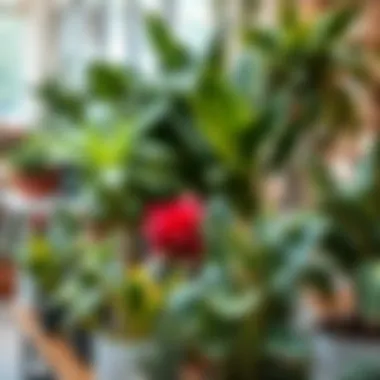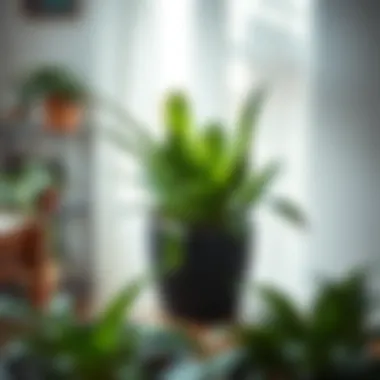Where to Buy Quality House Plants: Your Complete Guide


Intro
House plants are more than just decorative elements in a home; they contribute to overall well-being, air quality, and can even boost creativity. With the increase in accessibility to a plethora of choices, navigating the houseplant market can feel like a daunting jungle. Whether you're an experienced plant parent or new to the green thumb game, knowing where to find quality plants is essential. This guide aims to unveil the best sources for purchasing house plants while catering to different preferences and budgets.
In this exploration, we’ll break down familiar retail spaces and emerging online platforms, shedding light on factors like plant variety, quality assurance, and pricing. We'll also touch on practical tips for selecting the right plants to fit your space. By the end of this guide, you will be ready to make more informed decisions, ensuring your home flourishes with vibrant plant life.
Retail Stores for House Plants
When it comes to buying house plants, local retail stores often provide a tactile shopping experience that online platforms can't quite replicate. You can observe the plants firsthand, ensuring that they are disease-free and vibrant.
Nurseries and Garden Centers
These establishments usually have a vast selection of plants, ranging from the humble snake plant to the more exotic monstera.
- Personal Touch: Staff can offer advice tailored to your specific needs, helping you choose the right plant for your environment.
- Seasonal Offerings: Many nurseries adjust their stock according to the season, giving you the chance to snag rare varieties or local plants.
"The best part about shopping at a local nursery is knowing that your plants are often locally grown and acclimated to the surroundings, which can enhance their growth."
Big Box Retailers
Stores like Home Depot or Lowe's can be a goldmine for affordable plants. They cater to mass markets which means prices can be lower, but often at the expense of quality.
- Convenience: These retailers usually have extended hours and a more extensive geographical presence.
- Bulk Purchases: Ideal for those looking to renovate their home or undertake larger landscaping projects.
Online Options for House Plants
Adaptability to new technologies has transformed how buyers search for house plants. E-commerce platforms often provide an extensive array of choices that may not be readily available locally.
Specialized Online Plant Retailers
Websites like The Sill or Bloomscape focus solely on indoor plants and related accessories. These sites make plant parenthood easy.
- Detailed Descriptions: You can often find extensive care guides and plant details to help in your decision-making process.
- Subscription Services: Some retailers now offer subscription options to receive new plants regularly, beneficial for plant enthusiasts who want to expand their collection.
Online Marketplaces
Platforms such as Etsy and even Amazon can serve as unexpected resources for unique or rare house plants.
- Diverse Offerings: Since these platforms house many sellers, there's something for everyone, from rare tropicals to easy-care plants.
- User Reviews: Customer feedback often helps gauge the reliability of the seller, ensuring a more informed purchase.
Practical Tips for Choosing Your Plants
While locations to buy plants is crucial, selecting the right plant for your space can be even more significant. Here’s what to keep in mind:
Lighting Conditions
Evaluate light availability in your homes such as bright indirect light, partial shade, or full sun. Different plants thrive in varying conditions.
Size and Space
Before making a purchase, assess the size of the plant compared to your space. Big plants can dominate a room, while small ones might get lost.
Closure
Understanding the House Plant Culture
In today's fast-paced world, understanding the house plant culture has become a vital aspect of many people's lives. House plants are no longer just decorative items; they serve as companions that can bring warmth and character into a living space. The rise of indoor gardening reflects a growing trend, urging homeowners, designers, and even DIY enthusiasts to embrace flora like never before. With a blend of aesthetics and functionality, house plants contribute not only to our home decor but also to our mental and emotional well-being.
The Rise of Indoor Gardening
Over the past few years, there’s been a remarkable surge in the popularity of indoor gardening. This boom can be seen in the countless social media posts showcasing vibrant greens sprouting in various corners of homes. People are digging their hands into the soil and reconnecting with nature, albeit from the comfort of their living rooms. The shift toward urban living, where space is often at a premium, has propelled many into the realm of indoor gardening. From window sills to kitchen counters, plants find their place in any nook and cranny.
Growing house plants allows individuals to personalize their spaces and create sanctuaries amidst busy lives. Add to that the ease of care for many house plant varieties today, and it’s easy to see why folks are choosing to cultivate their own little green ecosystems. Furthermore, the advent of social media platforms has enabled plant enthusiasts to share tips, tricks, and experiences with a wider audience, fostering a vibrant community that resonates with the challenges and triumphs of plant parenting.
Benefits of Having House Plants
The benefits of bringing plants into our homes are substantial, influencing both our environment and mental health. Studies have shown that house plants can improve indoor air quality by filtering pollutants and increasing humidity, which can lead to better respiratory health.
- Enhances Mood: Research indicates that simply being around greenery can elevate one's mood and reduce stress. The act of caring for a plant and watching it grow can provide a sense of achievement and purpose, countering feelings of anxiety.
- Boosts Productivity: In environments like home offices, having plants can increase focus and productivity. A splash of green may do wonders in terms of creativity and concentration levels, making tasks feel less daunting.
- Improves Aesthetics: Beyond health benefits, house plants add a touch of life to any space. Whether it’s a succulent sitting on a bookshelf or a tall fiddle leaf fig in the corner, plants can create visually appealing arrangements that draw the eye and invite conversation.
- Connection with Nature: In an era dominated by screens, having plants can bridge the gap between the digital and natural worlds. Engaging with plant care fosters a deeper appreciation for nature's cycles and rhythms, promoting a more conscious way of living.
As the house plant culture continues to evolve, understanding these elements becomes imperative for anyone looking to purchase or care for plants. The growing popularity is a testament to how a simple green addition can enrich our lives.


Evaluating Your Needs
When it comes to purchasing house plants, understanding your personal needs is crucial. It’s not just about what looks pretty in your home; it's about compatibility with your living space and lifestyle. By evaluating your specific requirements, you can ensure that the plant you bring in does more than just occupy space – it should thrive and enhance your environment.
There are two significant facets to consider when evaluating your needs: assessing your space and understanding your maintenance preferences. Getting these aspects right can save you from future headaches and disappointment.
Assessing Your Space
The first step in your plant purchasing journey is to take a long, hard look at your space. Every nook and corner in your home tells a story about the right plants that could fit. Are there bright, sun-soaked windows where a vibrant cactus would flourish? Or is there a cozy, dim corner that would be perfect for a snake plant, which thrives in low-light conditions?
Here are a few considerations for assessing your space:
- Light Levels: Note which areas of your home receive direct sunlight and at what times.
- Humidity: Some plants, like ferns, prefer higher humidity, which is often found in kitchens or bathrooms.
- Size: Take into account how much room you have. A large potted palm can dramatically change a space but might overwhelm a small apartment.
- Allergens and Pets: If you have pets or allergies, choose plants that are safe and less likely to induce sneezing fits.
By thoroughly evaluating these aspects, you’ll set the stage for which plants will thrive and which won’t.
Choosing Between Low-Maintenance and High-Maintenance Plants
Once you've assessed your space, the next step is deciding on the type of plants that suit your lifestyle. Do you have time to devote to plant care, or do you need something that can survive a bit of neglect? The distinction between low-maintenance and high-maintenance plants can make or break your plant ownership experience.
- Low-Maintenance Plants: These are the superheroes for busy folks. Options like pothos,ZZ plants, or succulents can survive with minimal attention, making them perfect for beginners or those with a hectic schedule. They're resilient and don’t require frequent watering or special care.
- High-Maintenance Plants: If you’re someone with a green thumb who loves nurturing plants, exploring high-maintenance plants can be rewarding. These might include varieties such as orchids or fiddle leaf figs, which do require a bit more love, attention, and understanding of their specific needs. While they may be demanding, they often reward you with stunning displays and strong growth when cared for properly.
Local Nurseries and Garden Centers
When diving into the world of house plants, local nurseries and garden centers often fly under the radar, but they pack a punch when it comes to diverse plant selections and personalized experiences. These venues can offer not just a purchase, but an entire journey into horticulture. Whether you are a skilled green thumb or a novice plant parent, tapping into the expertise available at local establishments can significantly improve your plant-care success.
The heart and soul of local nurseries lie in their commitment to providing healthy, thriving plants tailored to your regional climate. Since they typically source their stock from nearby growers, the plants often adapt more seamlessly to your living conditions than those from far-flung distributors.
Moreover, the charm of buying locally goes far beyond just plant quality. By engaging with local businesses, you contribute to your community and promote sustainable practices. This is especially pertinent as many nurseries engage in ethical sourcing to protect both the environment and plant biodiversity.
Advantages of Buying Locally
Going local for your plant purchases has a multitude of upsides. Here are some compelling reasons to frequent your neighborhood nursery:
- Expert Advice: Staff members often have hands-on experience. They can provide localized advice that online retailers simply cannot match. If you’re unsure which plant will thrive best in your home, a quick chat with the store manager can yield golden insights.
- Plant Selection: Local nurseries tend to curate their stock based on what thrives in that specific area. This increases your chances of taking home a plant that stands a fighting chance against your home environment, reducing the trial and error.
- Quirky Varieties: Many of these nurseries carry unique house plants you might not find in big-box stores or online—rare succulents, indigenous species, or beautifully potted arrangements can often feel like hidden treasures.
- Community Engagement: By shopping local, you reinforce community ties and support small businesses that often share valuable gardening tips or host events like plant swapping.
"When you buy locally, you’re not just getting a plant; you’re gaining a reliable resource and a sense of belonging in the gardening community."
Key Features to Look for in Local Sellers
When you walk into a local nursery or garden center, keep a close eye on certain features that can indicate a quality seller:
- Healthy Plant Stock: Look for bright, green leaves without discoloration or wilting. Sturdy stems and absence of pests should also be telltale signs of well-cared-for plants.
- Knowledgeable Staff: A genuine passion for flora often shines through in staff interactions. If they're eager to answer questions and provide care tips, that indicates a commitment to customer satisfaction.
- Transparency: A trustworthy nursery will share information about their sourcing practices, pest control methods, and plant care strategies.
- Local Sourcing: Check if the nursery sources plants locally. If they do, it's more likely that the plants are healthy and accustomed to the local climate.
- Return Policies: A solid return policy shows confidence in their products and provides peace of mind for you. A seller that stands behind their plants will often offer some kind of warranty or replacement guarantee.
By keeping these features in mind, you can ensure a fruitful visit to your local nursery or garden center. With a bit of research and a discerning eye, you can transform your plant shopping escapade into a rewarding experience that contributes both to your home and the community.
Online Marketplaces
When it comes to purchasing house plants, online marketplaces have transformed the way gardening enthusiasts approach their green-thumb journey. These platforms connect buyers with a vast array of sellers, allowing for an unparalleled selection of plants, from the run-of-the-mill pothos to rare exotic species that might not be available at local stores. One of the critical benefits of shopping online is the convenience; you can browse varieties without leaving the comfort of your home and often access customer reviews that might steer your purchasing decisions.
Popular Platforms for Plant Shopping
Amazon
Amazon stands tall as one of the giants in the e-commerce landscape, offering everything under the sun, including plants. What truly sets Amazon apart is its breathtakingly extensive inventory and the convenience of Prime delivery. Most buyers appreciate the speedy shipping options that let you get plants to your doorstep in no time – sometimes even the same day! However, while Amazon offers a broad range, customers should watch for vendor reliability, as the quality can vary significantly between different sellers. A useful tip is to focus on products with robust customer reviews and high ratings.
One unique feature of Amazon is its detailed product descriptions and images, aiding buyers in making more informed decisions. But, be wary of overzealous sales; at times, a seller might list plants at inflated prices. Keeping an eye on the prices and cross-referencing with other platforms can often yield better deals.
Etsy
On the flip side, we have Etsy, a delightful marketplace that champions the unique and handmade. This platform has garnered a loyal following among plant lovers for its curated selection of independent sellers who often carry uncommon varieties. Buying from artisans means you often get more than just a plant – you get a story.
What makes Etsy noteworthy is the emphasis on creativity and personal touch. Many vendors provide growing tips or peculiar plant care instructions, tying in a sense of community. However, one downside could be the shipping times; plants from small sellers might take longer to arrive compared to giant retailers. But receiving a lovingly packaged plant makes the wait feel worthwhile to many. The uniqueness of the offerings is often worth a small trade-off in delivery time.
eBay
Then there’s eBay, which often resembles a treasure hunt for gem plants. Unlike traditional retail platforms, eBay features auction listings alongside fixed prices, allowing for serious bargain hunters to snag desirable plants at lower costs. It’s a great way to try out your negotiation skills as you bid on listings.
A major appeal of eBay is its diverse selection; you might find everything from sought-after rare breeds to local varieties. However, potential buyers should tread cautiously. With a mix of individual sellers, quality assurance can vary wildly. Buyers are encouraged to proceed with thorough checks on seller reputations and read descriptions closely to avoid pitfalls. The thrill of finding a perfect match may outweigh the risks for enthusiasts, but it's always wise to keep eyes peeled.
Navigating Online Prices and Offers
As the digital marketplace swells, navigating prices and various offers becomes essential for savvy shoppers. The first step involves setting a budget that aligns with your preferences; larger plants often command heftier price tags. Tools like price tracking apps or extensions can help monitor fluctuations and sales on the dolls you’ve set your sights on. It’s also wise to compare similar offerings across different platforms to ensure you’re not paying more than necessary.


Specialty Plant Boutiques
When it comes to finding extraordinary plants, specialty plant boutiques stand out as a beacon for enthusiasts and novice gardeners alike. These unique establishments often carry a curated selection of flora that sets them apart from the run-of-the-mill retailers. The importance of such boutiques cannot be overstated, especially when considering they frequently prioritize exclusive varieties, rare species, and unusual plant types that you might not find anywhere else. For homeowners and designers looking to elevate their indoor spaces, these boutiques offer the chance to discover gems that infuse character and distinctiveness into any decor.
Features of Boutique Plants
Boutique plants generally come with their own set of characteristics that distinguish them from typical options available elsewhere. Here are some of the standout features that make boutique plants particularly appealing:
- Specialty Varieties: Many boutiques focus on unusual cultivars or native plants that are tailored to specific conditions or aesthetics.
- Quality Assurance: These plants are usually grown with care, ensuring healthier and more robust specimens. You can commonly expect rigorous attention to detail in their cultivation, with respect to environment and care practices.
- Expert Guidance: The employees are often well-versed in plant care and can provide tailored recommendations based on your needs and environment. This personalized service helps foster better plant care habits.
- Creative Presentation: The way plants are displayed in boutique shops often emphasizes beauty and design. This can be beneficial for interior decorators seeking inspiration for floral arrangements and plant placements.
Additionally, many boutiques have an aesthetic ethos that enhances your shopping experience through themed plant arrangements or creative pots that can complement your home’s style. The ambiance of a boutique can also be enjoyable, creating a sense of community among plant lovers.
Understanding the Premium Pricing
One notable aspect of purchasing from specialty plant boutiques is the premium pricing attached to many of their offerings. Although this may feel daunting at first, upon closer examination, the price tag often reflects several key factors:
- Cultivation Expertise: Plants sold at these boutiques are often cultivated by knowledgeable growers who practice specialized horticultural techniques. This means that the plants are not just bought; they are cared for in a way that guarantees their health and longevity.
- Limited Availability: Due to their unique selection of plants, these boutiques often deal with limited stock, which raises the price. Rare varieties tend to be more expensive simply because they are harder to find.
- Quality over Quantity: Unlike big-box retailers that might have wider varieties of lower-quality plants, boutique plants usually represent a commitment to quality. The additional cost is a reflection of the assurance you are getting a durable plant that has been nurtured properly.
- Sustainable Practices: Many plant boutiques adopt sustainable and ethical sourcing practices, cultivating plants in ways that minimize environmental impact. This often comes with higher costs, but it also means you’re supporting eco-friendly business practices.
In essence, while the premium pricing may seem steep at a glance, what you’re receiving is much more than a mere plant. It’s an investment in quality, uniqueness, and the opportunity to cultivate a thriving piece of art in your own home.
"Buying from a specialty plant boutique is not merely a transactional experience but an artistic endeavor that signifies respect for both the environment and the beauty that plants can bring to our lives."
If you're willing to put forth the extra monetary effort, these venues can significantly elevate your plant game. Armed with an understanding of both the features and pricing, you can make informed choices that will enhance your living space with flair and individuality.
Buying Plants from Big-Box Retailers
Purchasing plants from big-box retailers can be a double-edged sword. On one side, these stores offer convenience and variety, often making it easier for homeowners and decorating enthusiasts to find plants that fit their space without too much hassle. On the flip side, there are considerations one must keep in mind, especially when it comes to quality and the health of the plants.
When you walk into a well-known store like Home Depot or Lowe's, you might be greeted by a vast array of plants, from common varieties like spider plants to more exotic offerings. This broad selection can be appealing. However, it’s essential to approach the buying process with a discerning eye.
Evaluating Quality in Volume Purchasing
In the hustle and bustle of big-box retail, it can be easy to overlook plant health as you revel in the sheer volume of choices. Nonetheless, being vigilant is crucial.
- Batch Quality: Many big-box stores source their plants in bulk. This can lead to inconsistencies in quality. Some plants may thrive while others are struggling. It’s advisable to compare several plants within the same batch and look for signs of health. Yellowing leaves or wilting may indicate poor care prior to sale.
- Care Instructions: Check if the store provides clear care instructions. The absence of proper guidance may reflect a lack of concern for plant well-being. Transparent care details can be indicative of how the retailer values the plants.
- Return Policy: A generous return policy can serve as a good hedge against purchasing unhealthy plants. If a plant sustains damage soon after you bring it home, being able to return it can save you time and money.
Exploring Exclusive Brand Offerings
Some big-box retailers partner with exclusive brands to offer unique plant varieties that you won't easily find elsewhere. This can include collaborations with local growers or specific plant breeders. Here are some points to consider:
- Unique Varieties: Searching through these exclusive collections can lead to the discovery of unique varieties that suit your personal style or home ambiance. For instance, a collaboration with a renowned plant breeder might yield a new cultivar that is both beautiful and hardy, giving you the best of both worlds.
- Brand Credibility: Look for brands that have a solid reputation in the horticultural community. Trustworthy brands tend to maintain better standards in plant care and production.
- Special Promotions: Keep an eye out for seasonal promotions or sales that feature these exclusive offerings. Often, unique products are discounted during special sales events, allowing you to score a high-quality plant at a lower price.
In summary, while big-box retailers present a convenient shopping option, it’s vital to conduct a bit of due diligence. Assess the quality of the plants, explore exclusive brands for unique finds, and remain aware of how plant care instructions reflect the retailer’s commitment to plant health. Making informed choices in such retail environments can lead to thriving home greenery that enhances your living space.
Shipping Considerations When Buying Plants
When you decide to order house plants online, shipping becomes a crucial factor in ensuring your green investments arrive in prime condition. The journey your plants take from their current location to your home can be fraught with challenges. Understanding shipping considerations is essential for anyone looking to make a successful online purchase. Various factors, from packaging to handling practices, can ultimately influence the vitality and longevity of your new plants.
Ensuring Safe Delivery
The first step in ensuring your plants arrive safe and sound is to pay attention to the seller's shipping process. Here are a few things to consider:
- Shipping Timeframe: Check how long it will take for the plants to reach you. Fast shipping minimizes the risk of stress on the plants, especially for delicate varieties. Some sellers offer expedited options, which can be worth the extra expense.
- Packaging Quality: Well-packaged plants are less likely to incur damage during transit. Look for sellers who use specific packaging materials that cushion the plants and prevent soil spillage. Bubble wrap, foam, and sturdy boxes are indicators of a seller committed to safe delivery.
- Tracking Options: Choose sellers who provide tracking numbers. This allows you to monitor your plants’ journey and gives you peace of mind. It also helps in planning when you'll need to be home to receive the delivery, ensuring the plants don’t sit in an uninhabited porch for too long.
- Favorable Weather Conditions: If you live in an area with extreme temperatures, consider timing your purchase. Plants can suffer in transit if exposed to frost or heat. Some sellers only ship during certain months, which is a good practice for maintaining plant health.
Remember: When it comes to shipping plants, proactive measures can make all the difference between a thriving addition to your home and a wilted collection of leaves.
Dealing with Damaged Goods
Despite all precautionary measures, unfortunate incidents can still occur. Preparing for the worst is part of being a responsible buyer. Here’s what to do if your plants arrive damaged:
- Document Everything: Take clear photographs of the plants and packing materials immediately upon opening the package. This documentation will be crucial for any claims.
- Contact the Seller Promptly: Reach out to the seller right away. Provide them with all the necessary information, including your order number and the condition of the plants. A good seller will want to resolve the situation swiftly, whether through a replacement or a refund.
- Know Your Rights: Familiarize yourself with the seller’s return and refund policy. Some may require you to send plants back, while others will simply ask you to provide evidence of damages.
- Learn to Revive: Sometimes, plants that appear damaged can bounce back with proper care. If a plant has broken stems or wilted leaves, try giving it some time and appropriate care before assuming it’s a lost cause.
- Share Your Experience: Leaving feedback can help future buyers. Whether your experience was positive or negative, sharing your story contributes to the community and might push sellers to improve their practices.
In today's digital buying environment, paying attention to shipping considerations is paramount for plant lovers. Focusing on safe delivery methods and knowing how to handle damaged goods is the key to ensuring that your house plants not only arrive intact but also flourish in their new home.
Plant Health and Quality Assurance
When it comes to buying house plants, understanding plant health and ensuring quality assurance cannot be understated. This topic plays a crucial role in determining the long-term satisfaction and success of your indoor gardening endeavors. High-quality plants not only enhance the aesthetic appeal of your home but also contribute positively to your well-being, from air purification to providing a touch of nature in an otherwise sterile environment.
Moreover, knowing how to assess plant health means you’ll avoid the heartache of bringing home a plant that wilts away on your kitchen counter. With the increasing number of plant vendors, both online and in-person, buyers need to arm themselves with knowledge that goes beyond mere purchases. Understanding how to recognize vigorous specimens and how to spot potential pitfalls in the purchasing journey can save time, money, and frustration.
Recognizing Healthy Plants
Identifying a healthy plant isn’t just about choosing the shiniest leaves or the most vibrant colors. Healthy plants exhibit a variety of specific characteristics.


- Vibrant Leaves: Look for leaves that are full of life—deep green color is often a good sign. Yellowing or browning can suggest health issues ranging from nutrient deficiencies to poor drainage.
- Sturdy Stems: A strong, upright stem indicates a plant is well-rooted and strong. If a stem feels spindly or flops over, it may reveal a lack of vigor or improper care.
- Pest-Free Zone: Before purchasing, inspect the plant for any signs of pests. Small spots, sticky residues, and webbing around leaves can all point to potential infestations.
- New Growth: Search for new leaves or shoots. This growth signals that the plant is thriving and adjusting well to its environment.
- Overall Shape and Density: A healthy plant will have a lush, full shape rather than a sparse appearance. This density generally indicates sound growing conditions.
Remember, if the plant looks like it’s had a rough day, it might not be the best choice. Always aim for that sprightly, energetic look which suggests it’s ready to thrive under your care.
Avoiding Common Pitfalls in Plant Purchasing
The journey to becoming a successful plant parent can sometimes take unexpected turns. To navigate these waters smoothly, being aware of common pitfalls can make a world of difference.
- Skimping on Research: Always do your homework before making a purchase. Understanding the specific needs of the plant types that pique your interest is crucial. Choosing plants without considering your home’s light and humidity can lead to dire outcomes.
- Ignoring Return Policies: Some retailers have strict no-return policies on plants. Ensure you understand the terms and conditions. A transparent policy can provide peace of mind, especially for fragile specimens.
- Opting for Convenience over Quality: Avoid the temptation to purchase whatever is closest at hand without scrutinizing health or quality. Those nice, alluring displays may not always reflect plant vitality.
- Not Asking Questions: Don’t be shy about engaging sellers about their plants’ history. Inquiring about care routines and whether the plants have been acclimatized to indoor environments can shed light on how they might fare in your space.
- Ignoring Seasonal Changes: Be mindful of the season when buying. Some plants may not thrive if purchased out of their natural growth cycle, leading to disappointment as they slowly decline.
In short, arming yourself with the right knowledge, being proactive in your buying process, and taking a moment to thoughtfully consider your options can pave the way to a flourishing home garden.
Understanding Plant Care Essentials
Caring for house plants goes beyond merely picking them up from the store and placing them on a sunny windowsill. It’s a journey that intertwines with the very essence of plant life, offering benefits that not only enhance the aesthetic of your space but also improve your overall well-being. Understanding the core requirements of plant care is crucial when navigating the complex world of indoor gardening. As you delve into this subject, you will find that plant care is not just about keeping your green companions alive; it involves nurturing them to thrive in your home environment.
Basic Requirements for Plant Survival
When it comes to the survival of your precious plants, a few basic requirements must be met. Here are key aspects to keep in mind:
- Light: Different plants have varying light needs. For instance, succulents and cacti flourish in bright light, while certain ferns and pothos prefer indirect sunlight. Observe your chosen plants and understand their specific requirements.
- Water: Overwatering is a common pitfall for many novice plant owners. It’s often tempting to water regularly, but it’s essential to allow the soil to dry out between watering sessions. Always check the moisture level before reaching for the watering can. A simple rule is to insert your finger about an inch deep into the soil; if it feels dry, it’s time to add water.
- Soil: The right potting mix can make all the difference. For instance, orchids need a chunky mix for proper aeration, while ferns thrive in a rich, organic medium. Make sure to use high-quality soil that suits the plants you own.
- Humidity: Many house plants, especially tropical varieties, demand high humidity levels. If your home is too dry, consider misting your plants or placing a humidifier nearby.
- Temperature: Most house plants prefer a stable temperature between 65°F to 75°F. Rapid temperature fluctuations can stress the plants. Keep them away from drafts or heating vents to provide a consistent environment.
Understanding these fundamental needs paves the way for successful plant ownership.
"Growing house plants is like raising children; you need patience, knowledge, and the right environment."
Resources for Ongoing Support
Much like any passion or hobby, indoor gardening benefits greatly from a network of resources to aid in your learning and development. Here are a few you can tap into:
- Books: There are countless books on house plant care that range from beginner guides to advanced horticultural texts. Titles such as "The House Plant Expert" by Dr. D.G. Hessayon and "The Plant Lover's Guide to Houseplants" provide invaluable insights.
- Websites and Blogs: Online resources like The Spruce and Gardener’s Supply Company offer extensive articles and forums where you can learn from experienced plant owners. Reddit also has an active community in subreddits like r/houseplants where enthusiasts share tips and advice.
- YouTube Channels: Visual learners may benefit from dedicated YouTube channels focusing on plant care. Channels like Planterina and Gardenmarvel provide step-by-step guides and care tips that are both engaging and educational.
- Local Gardening Clubs: Connecting with fellow plant enthusiasts can provide mentorship. Local clubs often host workshops and meet-ups where knowledge can be shared.
- Plant Care Apps: Technological tools can help too. Apps like PlantSnap or Bloomscape can assist in identifying plants and reminding you of their care schedules.
The journey of plant care is continuous. The more you learn, the more confident you will become in your abilities to nurture and grow healthy, vibrant plants. Remember, with the right resources at your fingertips, you are never alone in this green adventure!
Sustainable and Ethical Considerations
The Importance of Ethical Sourcing
In today’s world, where information travels at the speed of light and choices abound, buying house plants isn’t just about filling your space with greenery. It’s crucial to consider how those plants were sourced. Ethical sourcing acts as a guiding principle, ensuring that plants are cultivated and sold in a manner that respects the environment and communities involved in their production. By choosing sellers who prioritize ethical sourcing, you're supporting practices that favor local growers and environmentally friendly methods. This not only helps protect ecosystems but also fosters fair working conditions for farm laborers.
A conscious decision to buy from ethical sources can make a significant impact. It’s about creating a ripple effect that extends beyond your living room. For instance, when you purchase a plant from a nursery that employs sustainable farming techniques, you're contributing to the preservation of biodiversity. Plants harvested sustainably can better adapt to changes in climate, maintain soil integrity, and support local wildlife.
Moreover, engaging in ethical sourcing supports local economies. Many small nurseries and specialty boutiques practice responsible cultivation and often educate their customers on the benefits of native plant species. This connection to your local community adds an extra layer of appreciation for the plants you bring home.
"Every small decision we make, even in our homes, can lead to larger shifts in societal norms and environmental health."
Sustainable Plant Choices
Choosing sustainable plants goes hand in hand with ethical sourcing. It involves selecting species that are known for their minimal impact on the environment while also considering their benefits for indoor air quality and aesthetic appeal. Opting for plants that are resilient and suited to your specific environment ensures they thrive with less intervention, which in turn reduces waste and enhances sustainability.
When selecting plants, consider native varieties that are more likely to thrive in your local conditions. Native plants are typically low-maintenance and require less water and fertilizer than exotic varieties. This not only conserves resources but also supports local ecosystems. Some popular choices include the Snake Plant, Spider Plant, and Pothos, all of which are known for their hardiness.
Additionally, look for plants that are grown without harmful pesticides or chemicals. Many sellers emphasize organic or pesticide-free options, which can drastically reduce your carbon footprint while contributing to your overall health and well-being. Here, specific certifications like USDA Organic can serve as a useful reference.
Incorporating sustainable plant choices is not just a trend; it’s a responsibility. It embodies a mindset that recognizes the interconnectedness of our choices and their potential consequences. With each plant selected, you’re helping cultivate a more balanced and sustainable future, not just for yourself but for generations to come.
Final Thoughts on Plant Purchasing
When it comes to bringing greenery into our homes, the process of purchasing plants isn't just a simple transaction; it's a step into a rich domain of mindfulness and aesthetic enhancement. Purchasing ideal house plants involves much more than simply choosing a variety. Making informed choices is crucial; where a plant comes from and how it's taken care of before making its way to your home can have lasting impacts on its longevity and your overall satisfaction.
"Plants don’t just brighten a room; they uplift our mood and well-being."
Being deliberate in selecting where to buy your plants can guarantee a more fulfilling experience. The plants you choose can reflect your personality and contribute to the ambiance of your living space, but ensuring they are of good quality is paramount. Factors such as the source’s reputation, plant health, sustainability practices, and customer service play significant roles in making a smart purchase.
Making Informed Choices
The world of plant purchasing offers a myriad of choices, and navigating these can feel like walking through a dense forest without a map. Here are key points to keep in mind:
- Research Local Sources: Always check local nurseries or specialty shops; they often provide insights into the care of particular plants, making it easier to make choices suited to your environment.
- Look for Reviews: Engaging with communities online, such as forums on Reddit or Facebook groups, can yield valuable feedback about various sellers and their offerings.
- Consider the Lifecycle: Think about how a plant will grow and adapt within your space, not Just its looks. Think about its maintenance—some plants might be beautiful but require more care than you're prepared to give.
- Emphasize Quality Over Price: It's tempting to leap at discounts, but cheap prices can lead to poor quality. Investing in healthy plants that thrive in the long run often proves more economical.
By taking these steps, buyers can reduce the risk of disappointment and increase the likelihood of nurturing thriving plant life.
Embracing the Journey of Plant Care
Once you've made your purchase, the adventure doesn't end; it merely begins. Plant care is a continual learning process that fosters connection between you and your leafy companions. Here's what to embrace:
- Be Patient: Each plant has a rhythm—some may thrive from day one, while others require time to adjust. Patience is key in observing their growth and needs.
- Monitor Regularly: Keep an eye on changes in your plants' appearance. Leaves might droop or turn colors. Respond quickly to these signals.
- Seek Knowledge: Don't hesitate to learn more about care techniques. Books, online articles, and gardening workshops can provide invaluable insights.
- Iterate and Improve: Every plant is a new experience. If something doesn't turn out as expected, take note and adapt your approach with future purchases. Collecting wisdom is part of the fun!
By fully embracing this ongoing journey, plant lovers can cultivate not just beautiful homes, but also sustainable habits, making your living space a true reflection of vitality and personal care.



